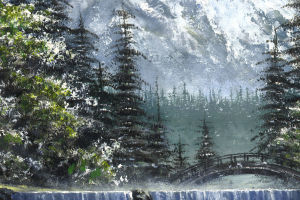Appreciating oil paintings is a fun artistic experience that allows you to immerse yourself in the artist's world and feel their creativity and emotions.
Oil painting is an ancient form of painting with a rich history and diverse styles. Therefore, to truly appreciate oil painting, you need to understand some basic knowledge about this art form and develop your aesthetic feelings.
Part One: The History and Development of Oil Painting
The Origins of Oil Painting
The history of oil painting can be traced back to the 13th century during the Middle Ages when artists first began using oil-based paints to create their masterpieces.
The earliest traces of oil paintings can be found adorning the walls of churches and monasteries across Europe, adorning murals and sacred icons.
However, oil painting reached its pinnacle during the Renaissance period, when renowned artists like Leonardo da Vinci, Raphael, and Michelangelo harnessed the power of oil painting techniques to bring their visions to life.
Mastering Oil Painting Techniques
The art of oil painting involves using oil-based pigments, often derived from linseed oil or blended oils, meticulously applied to canvas or wood surfaces.
These pigments are skillfully mixed and layered, resulting in a rich tapestry of colors and textures. Different brush strokes and implements are employed to create an array of textures and visual effects.
Oil paintings, due to the nature of the medium, require ample drying time, allowing artists to revisit and refine their works in multiple stages.
Exploring Oil Painting Styles and Genres
Realism: This genre aspires to depict subjects with meticulous precision, characterized by intricate details and lifelike colors. Prominent realist artists include Dutch master Johannes Vermeer and American virtuoso Andrew Whitwell.
Impressionism: Impressionist oil paintings emphasize the play of light and color, often employing bright and fragmented brushwork to capture the essence of a subject. Claude Monet and Pierre-Auguste Renoir are celebrated representatives of Impressionism.
Abstract Expressionism: Abstract Expressionism focuses on emotions and abstraction, conveying the artist's innermost feelings through bold brushwork and abstract shapes. Jackson Pollock and Willem de Kooning stand out as luminaries of Abstract Expressionism.
Part Two: How to Appreciate Oil Paintings
1. Preparation Before Gazing at the Canvas
Before embarking on your journey of appreciating oil paintings, acquaint yourself with the artist's background and oeuvre. Delving into the artist's biography, cultural context, and artistic style can enrich your understanding of the painting and its underlying narrative.
2. Scrutinize the Intricacies
Meticulously examine the painting's details, encompassing color palette, lines, textures, and shapes. Strive to discern the diverse techniques and elements employed by the artist, providing you with a deeper insight into the artwork.
3. Evoke Emotions
Oil paintings serve as emotional conduits, transmitting the artist's sentiments and thoughts. Tune into your emotions and intuition to gauge if the painting resonates with your inner sensibilities. Each individual's interaction with art is uniquely personal.
4. Contextualize with History and Culture
Apprehending the historical and cultural backdrop of a painting can augment your comprehension of its significance. Certain artworks may be intertwined with specific historical events or imbued with philosophical concepts, enhancing your grasp of the painting's essence.
5. Comparative Analysis
Appreciating a diverse array of oil paintings spanning various styles and genres can broaden your artistic horizons. Contrasting different works can unveil the distinctive characteristics and uniqueness of each style.
In essence, exploring oil paintings is a captivating and enlightening pursuit, enabling you to glean insights into diverse art forms and cultural histories. Cultivate a deeper appreciation and understanding of the enchanting world of oil paintings.
Remember, art is a subjective experience, and everyone can draw their own inspiration and meaning from it. So, relish the joy of gazing upon oil paintings and nurture your artistic sensibilities over time.


